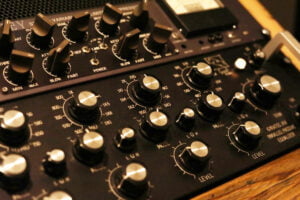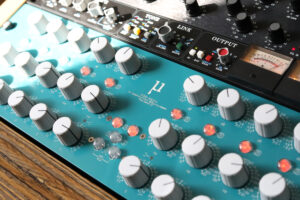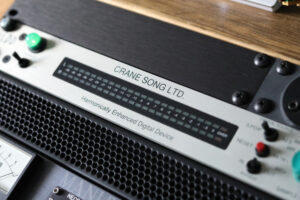The DAV Electronics Broadhurst Gardens No. 3 mastering EQ (DAV BG3) is a broad, tone-shaping EQ built by ex-Decca Records technician Mick Hinton. It’s limited in features, but excels at what it does. Sound-wise, it easily matches units three times its price.
What does the DAV Electronics BG3 sound like?
Falling under ‘clean analogue’, the DAV BG3 doesn’t have much of a sonic footprint. There’s no discernible ‘boxtone’ you get just from switching it in. But as with all great analogue gear, there is a forgiving musicality to it that is still difficult to replicate digitally.
The cavernously wide EQ curves have a solidity and depth that I’ve rarely come across in any other EQ. The low shelf, in particular, is a minor miracle. Boosting fills out the low-end beautiful, without muddying up the mix. Conversely, cutting a bass-heavy mix can free up remarkable amounts of energy while still retaining the impression of a hefty low-end.
And when an ‘air’ boost is required, a click or two at 32kHz is truly spectacular.
Why is the DAV Electronics BG3 useful?
The DAV BG3 is all stepped, with limited frequency selections. It’s not for making precise tweaks. Instead, its primary use is for broad tone shaping, defining the overall brightness or darkness of a mix before moving on to more precise changes. The shelves are so broad, if set correctly the DAV BG3 can act as a quasi-tilt EQ.
I use it at the front of my mixbus and mastering chain as a broad program EQ to define the overall frequency curve going into my API 2500. I then use the CAG HDE-250, Gyraf Gyratec XIV, or both, to make more detailed adjustments, having already got the track in the right ballpark with the BG3.
The DAV BG3 also features a fixed-frequency high pass filter. It’s usually set at 60Hz, but it’s common for mastering engineers to get it modified to 25Hz instead, as it is on my unit. When high pass filtering is required (often), 25Hz is an ideal frequency. And the DAV BG3’s filter sounds phenomenal. I can get more control using DMG Equilibrium, but nine times out of ten, I prefer to use the DAV BG3.
History of the DAV Electronics BG3
Back when labels like Decca kept production in-house, that often included the tools they used. The DAV BG3 is based on the mastering EQ Hinton built for the label in the 1970s. Hinton has introduced some newer designs now, but initially, everything that came out of his DAV Electronics brand was based on units he’d built for Decca engineers to use. As such, they are all extremely high quality, of a piece with Decca’s tradition of top-shelf classical and jazz recordings.
They are also eminently affordable for what they are, something Hinton achieves by prioritising sound and function over cosmetics. The DAV BG3 may look like an old piece of DIY hi-fi equipment, but all the knobs use ELMA switches, which you usually only find in the ‘mastering’ editions of already pricey equipment. Everything inside the box is as high-end as it gets.
Interesting features of the DAV Electronics BG3 at Old Cottage Audio
Aside from changing the filter frequency, the other common mastering mod for the DAV BG3 is swapping the stock 1.5dB switches for 0.5dB steps, as it is on my unit. However, on my unit, the faceplate still shows the 1.5dB values, with the ‘1’ scratched out in biro as a reminder that 1.5 is actually 0.5. My unit came from another mastering engineer who obtained his during Hinton’s early runs, before he matched the mastering mods with a new faceplate. I find the whole thing endearingly handmade and individual, the same way scratches on a second-hand vinyl record make it uniquely yours.
Explore more equipment

Gyraf Gyratec XIV
The Gyraf Gyratec XIV mastering EQ is a parallel passive tube EQ with a warm, luscious tone. The perfect character complement to a cleaner main mastering EQ.

Custom Audio Germany HDE-250
Essentially a Sontec-250 clone, the Custom Audio Germany HDE-250 main mastering EQ has become a modern classic in its own right.

Crane Song HEDD
The Crane Song HEDD is a stereo, mastering-grade AD/DA converter. It is an industry standard, most often seen in the racks of top-flight mastering engineers.
